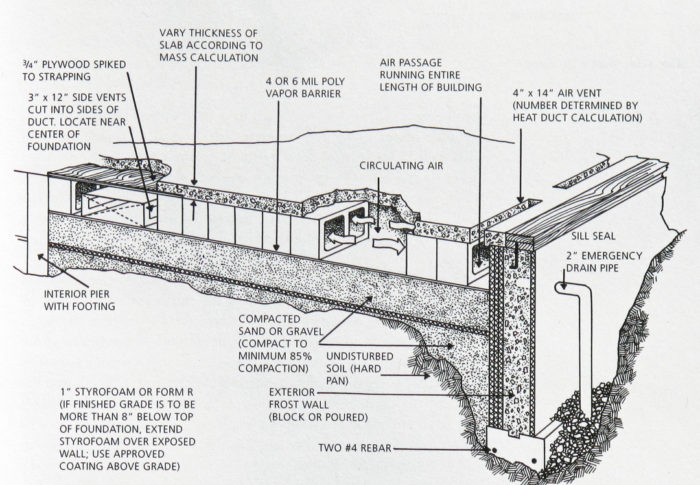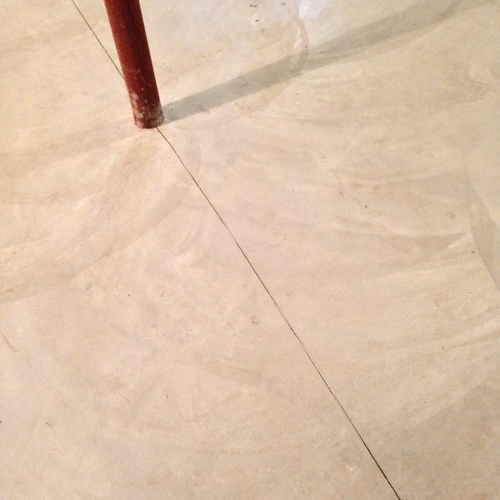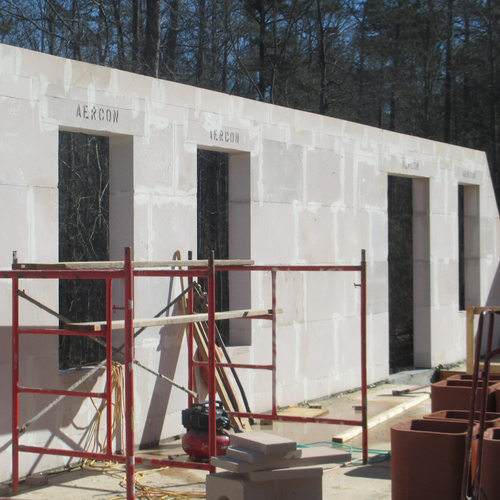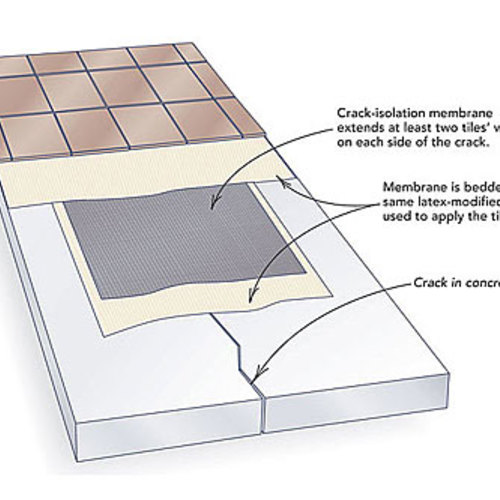
Image Credit: The Passive Solar House by James Kachadorian
Concrete floors with high thermal mass are often at the heart of passive solar designs. The density of concrete helps it store thermal energy and helps to reduce uncomfortable swings in indoor temperatures.
Slabs collect some heat from the sun through south-facing windows, often supplemented by radiant-floor heating systems that use a network of embedded plastic tubing to circulate hot water.
Nothing unusual here. But in a recent Green Building Advisor Q&A, Jay asks about the possibility of inserting air ducts directly in concrete to keep it warm.
“I’m interested if there is any added efficiency in passive solar applications where air is circulated through the slab,” Jay writes. “My impression is that this technique opens you up to a lot of potential moisture/mold scenarios. Does anyone know of any research that looks at the implications of this technique?”
Weekly Newsletter
Get building science and energy efficiency advice, plus special offers, in your inbox.
As usual, there’s no lack of opinion on the topic, although scientific studies that might answer Jay’s question definitively don’t seem to exist.
Some builders use this approach
AJ Builder points to the work of Bruce Brownell, who, he says, has “spent a lifetime designing, refining and building” this type of house.
“I have been in two of them,” AJ adds, and they are very livable environments. The owners almost heat alone with very small heat sources, hot water tanks, woodstoves or just the sun at many times…I think ducted slabs are a great choice among many.”
AJ includes a link to Adirondack Alternate Energy, presumably Brownell’s Edinburg, N.Y., company, which describes how the houses are heated. A small fan gathers heat at the peak of the house and distributes it through “a heavy (70-100 ton) mass storage system under the lowest floor, and back to the house interior perimeter.”
Houses…

This article is only available to GBA Prime Members
Sign up for a free trial and get instant access to this article as well as GBA’s complete library of premium articles and construction details.
Start Free TrialAlready a member? Log in















28 Comments
Underground Ducts
Come to NM and see thousands of HVAC ducts underground. During early spring, you must inspect the water level, especially after lots of snow or spring rain, which can bring lots of mold if not dried properly. Concrete will crack and though those crack you get moisture. Long a go I had to install a sump on a house that flooded every spring. Did I mention NM is a desert?
research?
The "Btu" comparison has been done, at the University of Illinois and elsewhere. https://www.ideals.illinois.edu/bitstream/handle/2142/4571/engineeringexperv00000i00412.pdf?sequence=3
Many National Homes from the late 40s and the 50s were built with ducts embedded in slabs. Water entry into the ducts was, and is, unfortunately common, so many such subslab systems have been abandoned. Add fire and radon to the concerns raised above.
Before lamenting lack of research, either to support or criticize some "new" approach, it would be good to at least look into the wide range of foundation research that has been done. Bareither (Illinois), Bahnfleth (Penn State), The Building Foundation Design Handbook (Labs et al.), Carl-Eric Hagentoft (Lund, Sweden, but published in English), Gintas Mitalas (NRC Canada), Underground Space Center at University of Minnesota, CMHC Canada...good stuff, well worth investigating by anyone trying to improve building foundations.
Response to Bill Rose
Bill,
Thanks very much for posting the link to the study on the thermal performance of slabs with embedded ducts. I just read the abstract and scanned the report.
While the data are undoubtedly useful to researchers, it seems to me that this paper doesn't answer the question at hand, namely: what are the benefits, if any, attributable to the inclusion of sub-slab ductwork in a passive solar house?
If you know the answer to that question, please speak up! We're all dying to know.
answer the question?
Martin,
42.
Bill
hint
Hitchhiker's Guide to the Galaxy. Want a good answer you need to formulate the question well. Research answers general questions, usually with numbers. If the question as formed addresses a general design element (not a specific application), and the input assumptions and the output criteria are made explicit, research is at your service. "Does this design approach work" misses being a good research question on several counts. It can and should be answered, but by the designer, using research results for heat transfer, and moisture effects, to help make the case.
Research should inform design. Design may proof research, but research plans cannot arise from single or small-number designs.
My takeaway
Okay, Bill, here's my takeaway:
-- I haven't yet seen any reason to believe there are performance advantages to sub-slab ductwork.
-- Bill Rose of the University of Illinois has noted that "Water entry into the ducts [embedded in slabs] was, and is, unfortunately common, so many such subslab systems have been abandoned. Add fire and radon to the concerns raised above."
whole-house heat with a ducted slab
I was very interested to read Scott's article and the comments. Just a year or so into my first year as an editor at Fine Homebuilding (probably 1982 or so) I visited a "thermal envelope" house in PA. Masonry mass as well as duct channels were provided by hollow-core CMUs, just as in the drawing above. I actually detected a convective airstream in the airspace along the north side of the house, but I came away thinking this was much to much work and expense for the sake of energy efficiency. So far, there hasn't been a mention of radon, but I'd guess that if you''re blowing air through a slab most of the day, you'd better be concerned about this. I agree with earlier comments that thermal mass as an ingredient in energy-efficient construction has been surpassed by "build it tight & insulate (& ventilate) right."
Response to Tim
Tim,
Although you wrote "So far, there hasn't been a mention of radon," Bill Rose mentioned it, and I repeated his warning in the post immediately preceding yours.
Under Floor Air Delivery
* 12-08 UFAD Case Study in Enviromental Design & Construction magazine by Michael Jouaneh "The New York Times Building features a versatile underfloor air distribution (UFAD) system designed for comfort and efficiency. With this underfloor air system, The New York Times Company is able to air condition 10 degrees warmer than a typical system — at 68 degrees Fahrenheit — and gently pump this chilled air up from the floor rather than pushing air down from the ceiling at high velocity. Cooler air naturally fills the lower area of the room and rises when it hits warmer objects such as people or computers. The warm air then exits through vents in the ceiling. This system not only saves energy, it also ensures a much more regulated, comfortable temperature throughout the space
you may want to look into airfloor
http://www.airfloor.com has a pretty decent system for subslab/topping slab ductwork.
Under Floor Air Delivery
The Romans used a similar system of heating the floor of raised villa.
It works but not better
There's no doubt that theses systems work, but they havent proven to be better than a regular slab. They are more complicated, expensive and seem to create more problems than they solve. Ahh technology...
I live in the greater Phoenix
I live in the greater Phoenix area, also know as the "Valley of the Sun". My grandfather had a 55 gallon drum painted blank on his roof to provide hot water. It worked pretty good! I just recently ripped off the two solar hot water panels from my garage roof. They were very corroded and the roof leaked where the pipes went through every time it rained. I 'm sure the new Heliodyne unit will work better - no more water on the roof, it uses an exchanger. With time technology gets better and reveals our previous shortcomings. Underground ducts or "shallow geothermal" will evolve as well I suspect. At age 64 it's not the radon but the weight of the concrete blocks that concern me most. I need a technology update real soon.
Response to Steve Theis
Steve,
Underfloor heating systems based on ductwork or flues -- hypocausts to the Romans, ondol in Korea -- are indeed ancient. The question is, do they offer any advantages to modern builders or homeowners? I think not.
In-slab ducts
Martin and others, As i've said in my "Contrarian" blog and in several other posts on this site, I am a stong believer in this approach and have lived in such houses for over 30 years. A few comments on some of the concerns mentioned above: Issues of water intrusion and slab cracking are simply a matter of good design and construction practices; concerns about fire may apply to the "envelope" design but not to infloor ducts; radon and mold is not an issue if the ducts are sheet metal or steel pipe lined an accesible as I always specify; the Airfloor product has inherent problems as I have discussed elsewhere.
I consider the advantages of this approach to include: Additional mass allows additional glass area and thus more heat stored and more energy saved; forced circulation into a slab provides much more uniform slab temperatures including in areas where there is no direct gain or where there is carpet or furniture; longer storage duration in sunless periods; the additional mass provides far better performance during warm weather.
The only downside is the need to run the furnace fan or other blower a few hours a day, not much different than running ceiling fans to destratify or a furnace to heat rooms not in the sunspace.
I currently have two clients building houses with similar designs, and if I ever build another house there is no doubt I will repeat this system.
thermal mass
The general function of thermal mass seems to be the pivot point of this discussion. As was pointed out,the cost/benefit in terms of the environment is the key question in terms of the building process,but if you look at mass and the thermal cycle in general ,its hard to overestimate the impact.The thermal profile of the surrounding landscape itself can have a large influence on the performance of any building.Since designers tend to look at most projects and problems as they are confined by the edge of the drawing board, and the lifetime of a given structure,a true understanding of green building isn't near yet.A bit philosophical,but then art creeps into the discussion also...
thermal mass
Well..I didn't realize how incoherent that was going to sound.A comment on the specific case as illustrated.Though there is heat transfer in this design it seems to me the surface area for this transfer is minimized by the use of concrete block instead of a rock bed.I recognize that approach is a relic of the 70's,but in terms of the physics it's sound. A well insulated house is the most flexible way to build ,but if thermal mass is easily available and can be incorporated with little extra expense (ducts and fans are not budget killers) there is a case to be made for the stability of temperature it offers.My main interest in a rock bed system is for a greenhouse.If the goal is simply to stay above freezing and there is minimal insulation along with huge temperature swings, the addition of thermal storage and the cost of running a fan is an easy choice.At the other end of the design spectrum would be a super-insulated house with small windows. Added thermal mass would be all but useless. Somewhere in between is the balance that each house requires based on the preferences of the inhabitants.I would be happy living in a greenhouse,myself.
air duct in floor from AAE
It would be great to have both Don Roscoe and Bruce Brownell respond to this thread. I know Mr. Brownell has been doing detailed recordings in several of his homes that are up to date. People with the background here should be able to have a conversation with these two men who have been building these homes for many years to get the benefit of what they have learned. He has been building with the external insulation sheathing for years before the BSC habitat designs. When I saw the BSC homes I thought they copied Mr. Brownell's design except did not use his slab.
Also, I have taken a course from Don Roscoe where he discusses his slab which is essentially the same as AAE. They claim superior function and it would be a great service to builders and hopeful home owners to confirm their claims. Can a discussion with these designers be included here?
Solar Nova Scotia
http://www.solarns.ca/ship.php
This link is a duct system in slab like the Roscoe design. It is different from AAE in that the AAE pours a thin slab, puts the ducts on this and then adds thick slab to cover the ducts. I have no association with either of these men other than a great interest in if it works well enough to put in a new home I am planning.
insulated floors for air
Technology is here, this type of flooring is possible, by using span crete flooring. The ends can be cut at 45 degree angles where they meet in the corners, and sealed at that joint. Span Crete can be made to any length you order, and already has the holes in it, that will be used to move the air. Span Crete is also twice as strong as regular concrete, there- by eliminating the need for the top flooring (concrete) over it. No problem with Argon Gas, as the complete system will be sealed forever, and you don't need sheet metal in them. Hope this helps you guys.
Ducted slab in occasional-use residence?
I am designing a small (1600 SF) vacation house in the Berkshires of Western Mass. and am considering a ducted slab. The site has decent solar access but slopes down to the north, so that the walkout basement will have a slab floor that gets no direct solar gain. I would like to use lots of glazing on the upper level, and duct hot air down to the basement slab. When occupied, a wood stove in the basement would supply direct radiant heat as well as hot air that would rise through the house and return to the slab. Because the house would be used only intermittently in the winter, my goal is to avoid installing any heating system at all, other than the wood stove, (and electric resistance as a backup to keep the pipes from freezing.) I plan to add PV at some point to offset the electric hot water and backup heat (if needed). If I allow the temperature of the building to fall into the 40's when unoccupied, is it reasonable to assume that I can get away with little or no heating when unoccupied? Should I plan on a mini-split instead of the resistance heating for backup (or occasional use?)
I have followed this thread with great interest, and would love to hear how the fact that it is a non-primary residence may affect opinions regarding the use of thermal mass - in this case, as an alternative to fossil-fuel heating. I am also considering thermal shutters for North and East glazing (the west will have very little) for unoccupied periods.
Response to Michael Plehn
Michael,
1. Under no circumstances is it advisable to embed ducts in a slab on grade (or below grade), nor to install ducts under a slab on grade (or below grade).
2. During the winter in New England, thermal mass doesn't do much good.
3. If you need to raise the temperature of your home when it is unoccupied, a ductless minisplit will obviously have a lower operating cost than electric resistance heat.
4. Investments in extreme airtightness (approaching Passivhaus levels) will pay off.
Brownell study
A lot of data in this report on two Brownell houses dated Nov 2010: Adirondack Alternate Energy Passive Solar Houses at Hyspot and Kilmer Final Report prepared for the New York State Energy Research and Development Authority http://www.nyserda.org/pdfs/aae_report.pdf. I suspect some extra heat storage occurs in the ducted slab. The circulation of air throughout the house probably has more benefit...reducing stratification, colder rooms on the north side and overheating on the south.
Response to Martin H.
1. Not even when using deep foam layer insulation (to Passivhaus recommendations) and to code
radon remediation exhausting under that slab on grade? Or below grade slab?
Please explain?
2. Please inform the many people who have built with thermal mass and found a net benefit (in
New England) and other geographical areas that are far less environmentally ideal.
3. Indeed a ductless minisplit, as many have bright, experienced, and learned people have been
trying to tell North Americans for years and years.
4. Investments in airtightness is an essential in the building of any insulated/tempered
structure and is not described as 'extreme'; but as 'Best Practices". That 'airtightness' should be
determined by the type of structure, the chosen structural materials, its various components, its
expected outcomes, all in context to the actual environmental factors it is placed in.
Please note that an impervious structure can prove to be an environmental Trojan Horse and
result in 'very high energy" impacts in terms of the manufacture of its various components
and control systems, as well as the repair costs of, total life expectancy of, and the future
replacement costs of those components and of their control systems.
Response to Rhaud Macdonald
Rhaud,
1. I have seen enough problems with ducts installed beneath a slab on grade to know that they are risky and impossible to fix once moisture, mold, or radon problems develop. I stand by my advice: such systems have no advantages over alternative methods of heat delivery.
2. The reason that we don't see any thermal mass benefit during the winter in New England is that the outdoor temperature is below the desired indoor temperature for months at a time. To benefit from thermal mass, you need to live in a climate where the nighttime temperatures and daytime temperatures cycle above and below the desired indoor temperature, so that daytime heat can be stored in the thermal mass and released at night. That is not the case in New England.
3. Evidently we agree on the advantages of ductless minisplit units.
4. Although you apparently object to my description of Passivhaus levels of envelope airtightness as "extreme," we agree that such airtightness levels are desirable, advisable, and achievable.
Necro-thread revival, March 2023. I recently thought of the old Roman hypocaust system and wondered if I dare post a question about it here, and lo and behold, someone did many years ago.
My take is slightly different, as it doesn't involve thermal mass storage, but rather creating a large, warm-air mass in a well- insulated basement/storage area beneath the house (just a single-storey rancher), then distributing it into the upstairs rooms via small muffin fans in floor registers.
There would have to be consideration given to the connection between the basement and upstairs; obviously no open staircase (!) In a thermally-efficient house, this would eliminate the need for a large air handler, relying on the muffin fans to aid natural convection. The only large fan might be needed for return air.
Near Coastal,
The term for the volume of air you describe is a "plenum." Most furnaces already have a plenum -- usually, a galvanized steel box attached to the furnace from which the ducts originate (or to which the ducts return, in the case of the return plenum).
Can you use a basement as a plenum? In theory, yes -- but there aren't really any advantages to doing so. The main problem is air leakage (at the mudsill, at the sump, at the top of the stairs, at rim-joist penetrations, and at subfloor penetrations). Perfect air sealing is difficult. To work, a plenum needs to be pressurized -- and pressurized air finds air leaks.
In other words: lots of problems, no benefits.
To elaborate: basic math shows you the difficulties inherent in your idea. The amount of heat that a fan can move is calculated using this formula:
Heating BTUs = (cfm of the fan) x (delta-T) x 1.08
Where does the 1.08 come from? It's the heating BTU multiplier at sea level, determined by multiplying the number of pounds of air per cubic foot times the specific heat of air times the number of minutes in an hour (60). Another way of expressing this: the factor (1.08) is the volumetric heat capacity of air (in BTU * minute / hour * cubic feet * °F).
Your muffin fan moves very little air. Moreover, the delta-T between your basement and the rooms upstairs is small (unless, of course, you like to keep your basement at a very high temperature).
Thanks, Martin,
I I had always thought of a plenum as the sheet metal box you descrbe rather than a whole room, but of course in principle it's the same thing- a space that is filled ("plenus" = full, from what little I can remember of my school Latin) My "whole room plenum" idea assumed a carefully-sealed basement heated to about 75-80º and the fans assisting what (little) natural convection would occur with a small delta-t, the latter in retrospect being the main limitation. It must have been pretty hot in those Roman basements! And of course they were heating the stone floors as well.
The idea was to get away from a honking big fan for air handling, but you're right- the warm air needs to be pressurized to be properly distributed.. And nowadays a properly-designed and installed air handling system is probablly a lot quieter (and draws less power) than the wheezing geezer I remember from my old house many years ago.
Log in or become a member to post a comment.
Sign up Log in